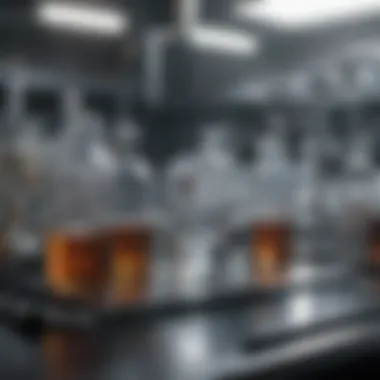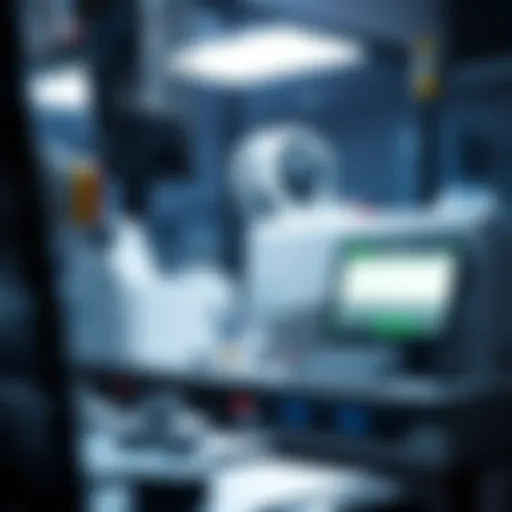Mastering Laboratory Equipment Identification


Overview of Research Topic
When one steps into the world of scientific exploration, they find themselves amongst a plethora of tools and instruments, each with its own significance. This section sets the stage for a comprehensive understanding of laboratory equipment—a realm that is crucial to the productive and precise nature of modern scientific practice.
Brief Background and Context
Laboratory equipment has a rich history rooted in the evolution of scientific inquiry. From the simple beaker to sophisticated chromatography systems, the evolution of these tools has mirrored advancements in scientific understanding. With modern research spanning disciplines such as biology, chemistry, and physics, knowing how to identify and utilize these instruments is invaluable for anyone involved in scientific work—be they students or seasoned researchers. Understanding laboratory equipment is not just about labels and functions; it involves grasping the underpinning principles that guide scientific investigation.
Importance in Current Scientific Landscape
The current scientific landscape demands precision and accuracy in experimental procedures. As such, identifying the correct equipment becomes paramount. Utilization of the right tools can mean the difference between success and failure in experiments.
"In the realm of science, equipment is often the unsung hero, setting the stage for discoveries that can change the world."
Consider this: a simple miscalculation or the use of an improperly calibrated tool can skew results entirely. Therefore, understanding the diverse categories of laboratory tools, their specific functions, and how they integrate into the broader context of research is critical. This article will lend clarity to these crucial elements, providing an all-encompassing guide to identifying laboratory equipment.
Methodology
In exploring laboratory equipment, it is essential to maintain a structured approach, ensuring that the nuances of each instrument are captured adequately. The following subsections detail the research design and techniques employed in gathering valuable insights.
Research Design and Approach
The exploration of laboratory equipment utilizes a qualitative research approach. This method allows for a deep dive into the functionalities and significance of various instruments, presenting real-world applications and scenarios where they come into play. Interviews with lab professionals and educators can offer practical perspectives, helping to illuminate the instructional aspects of this research topic.
Data Collection Techniques
To extract relevant data, various techniques are adopted, including reviews of scientific literature, observation of laboratory practices, and specialized interviews. For many researchers and students, firsthand experience with equipment within a lab setting forms a foundational understanding that theoretical knowledge alone cannot provide. By integrating these diverse perspectives, the exploration captures the essence of laboratory tools and their operational contexts.
Through this detailed investigation, readers will not only learn to identify laboratory equipment but also appreciate its significance in the broader scientific endeavor.
Foreword to Laboratory Equipment
Laboratory equipment is at the heart of scientific research, making it essential to understand its various facets. The exploration of laboratory equipment goes beyond just naming the tools; it dives into their functionalities, applications, and relevance across different scientific disciplines. Whether in the realm of biology, chemistry, or physics, the equipment used plays a crucial role in conducting experiments and gathering data. This section lays the groundwork, shedding light on how thoughtful identification and comprehension of laboratory tools can directly influence research outcomes.
Defining Laboratory Equipment
Laboratory equipment can broadly be defined as the tools and devices used for conducting scientific experiments, measurements, and various procedures. They serve as the backbone for daily tasks in research environments, enabling scientists to manipulate their materials in a controlled manner. From beakers to centrifuges, every item plays a unique role, allowing for precision and accuracy in experimental settings. It is not just a matter of possession; knowledge about the correct use and identification of these tools correlates with successful research endeavors.
Categories of Laboratory Equipment
General Laboratory Equipment
General laboratory equipment includes the essentials that support a variety of experiments and tasks. Items such as beakers, test tubes, and pipettes fall into this category. Their key characteristic is versatility; they can be found in virtually every lab, accommodating multiple tasks from mixing to holding samples. A beaker, for instance, is not just a simple container. It is designed with measurements on its side, allowing for accurate significant volume readings.
The uniqueness comes from how adaptable these instruments can be, making them a popular choice for many researchers. However, while they are widely used, one must remember that they do have limitations in precision compared to specialized instruments.
Specialized Laboratory Instruments
Specialized laboratory instruments serve a more refined purpose. Unlike their general counterparts, these devices are tailored for specific functions. Instruments like mass spectrometers or spectrophotometers enable detailed analysis of samples, proving to be invaluable in advanced research. Their distinguishing factor is the high level of precision and specific application each instrument is built for, allowing for thorough investigations in a focused area of study. The tough part? They often come with a steeper learning curve and higher costs, making accessibility a consideration in many labs.
If your research focuses on molecular behavior, a mass spectrometer offers clarity and insight that general equipment cannot provide.
Safety Equipment
Safety equipment is an indispensable category in any laboratory environment. This collection includes personal protective equipment (PPE) like gloves, goggles, and lab coats, designed to protect researchers from chemical spills, sharp objects, and other hazards. The hallmark of safety gear lies in its ability to minimize health risks—and that’s non-negotiable for any lab.
Unique features, such as fume hoods or safety showers, are designed to aid in maintaining a safe workspace. Employing this equipment reduces the chances of accidents, ensuring safe operations amidst potentially dangerous materials.
"The right equipment not only aids in achieving scientific milestones but also safeguards well-being in the lab."
Understanding these categories enhances awareness of how each piece contributes to the overall lab ecosystem. Identifying where a specific tool fits in the broader picture of laboratory work empowers students, researchers, and educators to make informed decisions, ultimately leading to better research outcomes.
Basic Laboratory Equipment Identification
Understanding basic laboratory equipment identification is akin to knowing the tools of a craft. Just as a carpenter wouldn’t pick up a hammer without knowing its purpose, scientists too must be familiar with their instruments to ensure accuracy in their experiments. Recognizing various pieces of lab equipment forms the crux of reliable data collection and analysis, making proficiency in this area not just beneficial but essential.
In this section, we’ll take a closer look at various types of basic laboratory equipment commonly found in educational and professional environments. This will help illuminate their features, uses, and why they matter in the broader context of scientific research.
Glassware Essentials


Glassware forms the backbone of most laboratory activities, offering both functionality and reliability for a range of tasks. When we talk about glassware, we primarily think of beakers, flasks, and pipettes. Each plays a distinct role in facilitating various scientific processes, so it’s worth getting to know these essentials a bit better.
Beakers
Beakers are the unsung heroes of the laboratory. These cylindrical containers are typically made of glass or plastic and come in various sizes, usually marked with measurement lines for added precision.
- Key Characteristic: Their wide mouth allows for easy pouring and stirring, making them versatile for mixing reactions.
- Contribution: They hold liquid samples during experiments, whether it's for mixing chemicals or simply storing solutions temporarily.
- Unique Feature: Beakers often have spouts, which offer a controlled pouring experience, minimizing spills. However, they shouldn’t be relied upon for precise measurements, as they’re designed more for volume than accuracy.
Using beakers can simplify many routine lab tasks, though it's essential to remember they don’t offer the precision some experiments require.
Flasks
Flasks, specifically Erlenmeyer flasks, are iconic in the lab environment. Their conical shape not only differentiates them visually but also increases their utility in mixing and heating substances.
- Key Characteristic: The narrow neck reduces evaporation and allows for effective swirling of solutions without the fear of spillage.
- Contribution: Flasks are often used for reactions that require gentle mixing or specific heating over time.
- Unique Feature: They can easily be sealed with a stopper, helping to minimize contamination of materials. However, their designs mean they can be trickier to clean than other glassware.
Flasks are particularly popular for titration procedures, capturing the essence of their utility in laboratory work.
Pipettes
Pipettes are essential for transferring liquids with precision. These slender tubes are indispensable when it comes to measuring exact volumes of liquid samples.
- Key Characteristic: Their ability to deliver precise volumes makes them crucial for experiments that require accuracy over mere volume.
- Contribution: Pipettes enable scientists to conduct a myriad of tasks, from transferring reagents to diluting solutions.
- Unique Feature: Some pipettes are automatic and offer adjustable volume settings, allowing for flexibility and efficiency in experimentation. However, they can be prone to pipetting errors if not calibrated properly.
These tools make sure that every drop counts, especially in analytical chemistry where precision is the utmost priority.
Measuring Instruments
Measuring instruments are the eyes of a lab, offering insights that inform scientific reasoning. They include balances, thermometers, and pH meters, each indispensable for conducting accurate assessments in a laboratory setting.
Balances
Balances are critical in any lab for measuring mass with the utmost precision.
- Key Characteristic: They come in different forms, like analytical and top-loading balances, each offering various levels of precision and capacity.
- Contribution: They ensure that samples are weighed accurately, facilitating the reproducibility of experiments.
- Unique Feature: Analytical balances are sensitive enough to measure small masses, down to a milligram, which can be vital in chemical experiments. However, they do require a stable environment to operate correctly, as even slight vibrations can lead to inaccurate readings.
Scientific inquiries often hinge on the accurate measurement of mass, making balances indispensable.
Thermometers
Thermometers are the stalwarts of temperature measurement, essential in various experiments where thermal conditions affect results.
- Key Characteristic: There are digital and traditional glass types, each providing a different range and method of reading temperature.
- Contribution: They inform reactions that are temperature-sensitive, ensuring optimal conditions for success.
- Unique Feature: Digital thermometers often offer quicker readings and higher accuracy versus glass ones, but the latter may withstand extreme temperatures better. Yet, they can also be fragile and require careful handling.
Temperature maintenance is a non-negotiable in many scientific contexts, and understanding how to use thermometers effectively makes a marked difference in experiment outcomes.
pH Meters
pH meters are key to assessing the acidity or alkalinity of a solution, an essential factor in numerous chemical and biological processes.
- Key Characteristic: They provide quick and precise readings of pH levels using electrodes immersed in the solution.
- Contribution: pH meters guide adjustments in experiments, especially in biological contexts where pH can significantly influence reactions.
- Unique Feature: They often come with automatic temperature compensation, a feature that enhances their accuracy, though they necessitate calibration for reliable results.
In the quest for precision science, pH meters help maintain essential balances in countless experimental landscapes.
Advanced Laboratory Equipment Identification
In the realm of scientific inquiry, the ability to accurately identify and utilize advanced laboratory equipment serves as a cornerstone for effective research and experimentation. These tools enable researchers to extract profound insights from complex materials, paving the way for notable discoveries across various disciplines. Advanced laboratory instruments are not just fancy pieces of machinery; they are crucial for providing reliable results, minimizing errors, and ultimately contributing to the integrity of the scientific method.
This section delves into high-tech analytical instruments and microscopy tools, which stand out for their precision and capability. Understanding these technologies is essential for anyone involved in scientific endeavors, be they students, educators, or seasoned professionals. Let's explore some of the most vital types of advanced laboratory equipment and their significance in the scientific landscape.
High-Tech Analytical Instruments
Spectrophotometers


Spectrophotometers play a pivotal role in qualitative and quantitative analyses of substances. These devices measure light absorption, allowing researchers to determine the concentration of solutes in a solution. The key characteristic that stands out about spectrophotometers is their ability to provide a rapid assessment of sample purity and concentration.
One of the noteworthy advantages is their versatility; they can analyze liquids and solids, creating a broad scope for applications in chemistry and biochemistry. However, it's essential to properly calibrate them to ensure accurate readings, as any deviation can lead to misinterpretations. In summary, spectrophotometers continue to be a popular choice in labs for their efficiency and reliability.
Chromatographs
Chromatographs, particularly in their gas and liquid forms, are indispensable when separating complex mixtures into their individual components. This characteristic of fractionating substances is vital in a multitude of applications, from pharmaceuticals to environmental testing. Chromatographs excel in delivering high-resolution separations and results.
Why are they so widely used? Their ability to discriminate between minute differences in compounds makes them invaluable. However, one can argue that they may require considerable expertise to operate, which can be a downside for novice users. Still, the analytical prowess they offer is irreplaceable in many settings.
Mass Spectrometers
Mass spectrometers shine in their functionality, primarily by measuring the mass-to-charge ratio of ions. This specific capability allows for the determination of molecular weights and structural elucidation of compounds. The key characteristic of mass spectrometers lies in their sensitivity, enabling the detection of extremely low concentrations of substances.
Their significance in fields such as proteomics, metabolomics, and environmental science cannot be stressed enough. Nonetheless, they can be costly and require meticulous maintenance. The benefits often outweigh their drawbacks, making mass spectrometers a mainstay in advanced laboratory settings.
Microscopy Tools
Light Microscopes
Light microscopes are fundamental tools in biological science that magnify samples using visible light. Their primary aspect is the optical magnification that allows researchers to observe details at a cellular level. Light microscopes are most often favored due to their relatively low cost and ease of use.
While they are indispensable for initial explorative studies, one must consider their limitations regarding resolution, especially when it comes to viral studies or detailed cellular mechanisms. Still, they serve as reliable first-line instruments for examining specimens in various life sciences.
Electrons Microscopes
Electron microscopes take microscopy to the next level by utilizing beams of electrons rather than light, vastly increasing the potential resolution. This particular feature allows scientists to observe structures at atomic scales, unveiling details that would otherwise be hidden under other microscopes. The precision offered by electron microscopes is vital in fields such as materials science and nanotechnology.
However, they demand extensive training to operate and maintenance is often complex and costly, which can limit their accessibility. Regardless, the insights gained through electron microscopy are extraordinary and impossible to replicate with traditional techniques.
Fluorescence Microscopes
Fluorescence microscopes add another layer of innovation by allowing scientists to visualize specimens that emit light upon exposure to specific wavelengths. This unique capability enables the study of cellular components tagged with fluorescent markers, making it invaluable for biological research, particularly in cellular biology.
The advantage of their high sensitivity in detecting low levels of fluorescence makes them a popular choice. Yet, the necessity for careful sample preparation and potential photobleaching are aspects to consider when using these microscopes. Overall, their role in elucidating complex biological processes is vital.
Functionality of Laboratory Equipment
Understanding the functionality of laboratory equipment is at the heart of successful scientific work. Each tool has a specific role, enhancing the accuracy and reliability of results in research and experiments. Without these instruments, conducting precise experiments and gathering data would be a less systematic endeavor, filled with guesswork and potential inaccuracies.
Importance of Accurate Measurement
Accurate measurement is like the backbone of any scientific inquiry. Whether you're weighing a sample, measuring liquid volumes, or determining temperature, precision ensures that your data holds water, so to speak. The implications of inaccuracies can derail an entire research project, leading to false conclusions.
- Quality Control: Regular measurements allow researchers to replicate experiments, validating findings and establishing credibility.
- Experimental Design: Well-defined measurements lead to better controlled experiments, enabling scientists to manipulate variables with informed decisions.
- Safety: In some cases, like mixing chemicals, precise measurement is critical. Too much of one substance can lead to catastrophic reactions, putting everyone at risk.
In laboratories, devices such as balances, pipettes, and thermometers serve this essential function. Each piece of equipment is designed to give readings as accurate as possible, equipped possibly with digital displays that minimize human error. While it's often an afterthought, consistent calibration of these instruments is necessary—like fine-tuning a piano before a concert.
Role of Laboratory Equipment in Experiments
Laboratory equipment plays a multifaceted role in experiments, going beyond mere measurement to facilitate the entire scientific process. It acts as a bridge between theory and practice, allowing researchers to test hypotheses, analyze data, and interpret results.
- Data Collection: Instruments such as spectrophotometers and chromatographs help in gathering quantitative and qualitative data which is fundamental for analysis. Without them, the vast ocean of experimental data would remain largely unexplored and uncharted.
- Observational Tools: Microscopes, for example, allow scientists to look deeply into the minutiae of biological and chemical samples. Observations made at the micro level can lead to breakthroughs in fields like medicine and materials science.
- Data Analysis: Post-experiment, certain tools are designed specifically to analyze and interpret the collected data. Statistical software linked with experimental instruments enhances this critical phase, providing visualized data along with deep insights into the performance of the experiments.
In essence, the way we utilize laboratory equipment shapes the trajectory of scientific discovery. As tools evolve, adapting alongside technological advances, the functionality of lab equipment becomes even more intricate, aiding scientists in asking bigger, bolder questions while grounding their research in the realities of measurable outcomes.
"Precision is not just a goal; it's the foundation of scientific progress."
Safety Considerations in Laboratory Settings
Laboratory environments are often alight with the energy of discovery, but this vibrancy can easily turn dangerous without the proper safety measures in place. This section sheds light on the importance of safety in laboratories and discusses practical elements that ensure a secure atmosphere for all personnel.
In any lab, safety considerations are non-negotiable. They encompass both physical safety and the well-being of individuals involved in experimentation, analysis, and research. Risk factors like exposure to toxic substances, biological dangers, or the misuse of complex instruments must always be kept in check. By prioritizing safety, laboratories can prevent accidents, reduce liability, and promote a culture of responsibility among researchers and students alike.


"An ounce of prevention is worth a pound of cure"; this old adage rings particularly true in laboratory settings where cautious practices can prevent a wealth of hazards.
Personal Protective Equipment (PPE)
Personal protective equipment is the first line of defense for anyone working in a laboratory. It includes a variety of safety gear designed to protect individuals from potential hazards. Without gear like lab coats, gloves, goggles, and face shields, lab participants expose themselves to various risks ranging from chemical spills to flying debris.
- Lab Coats: They shield the skin and clothing against spills and splashes, while also serving as a barrier against biological contaminants. Long sleeves are critical here, as they offer protection to the arms, which are frequently exposed during lab work.
- Gloves: Not all gloves are created equal. Nitrile gloves are often preferred due to their robust protection against chemicals and biological agents, while latex gloves should be avoided in settings where allergies are a concern.
- Safety Goggles: Eye injuries can have lifelong implications. Wearing proper safety goggles not only protects against chemical splashes but also provides a barrier against debris generated during experiments.
While it might seem tedious to wear this equipment, it becomes second nature with time, ensuring safety remains top-of-mind.
Proper Handling of Equipment
Taking care of laboratory equipment extends beyond mere cleanliness. Proper handling is essential for the longevity of instruments and safety of individuals. Equipment mishandling can lead to accidents, downtime, or costly repairs.
Here are a few critical aspects of proper handling:
- Training: All personnel should undergo training on how to properly operate instruments. Proper use mitigates risks associated with misuse or ignorance of correct protocols.
- Read Instructions: Before jumping into experiments, it’s always a good idea to read the manuals or heed any instructions that come with equipment.
- Keep Workstations Clean: Cluttered workspaces can lead to accidents. Regularly cleaning and organizing workstations creates a safe environment and aids in efficiency.
- Report Issues Immediately: If something seems off with a piece of equipment, don't ignore it. Reporting issues prevents accidents and keeps work flowing smoothly.
By focusing on equipment handling, labs can significantly decrease risks and foster an atmosphere of safety and responsibility.
Lab Equipment Maintenance and Calibration
The longevity and reliability of laboratory equipment hinges on proper maintenance and calibration. These practices are vital across various scientific disciplines, ensuring that the tools we use continue to provide accurate and reliable results. When laboratory instruments are maintained and calibrated correctly, researchers can trust the data they collect, thus underpinning the integrity of their experiments. Moreover, consistent maintenance can mitigate unexpected costs associated with repairs or replacements, extending the lifespan of the equipment.
Regular upkeep and precise calibration can also enhance safety in the laboratory. Malfunctioning equipment not only yields inaccurate results but can also pose risks to the lab personnel. Therefore, understanding the importance of maintenance and calibration sets the groundwork for rigorous research and safety protocols.
Routine Maintenance Guidelines
Routine maintenance involves day-to-day tasks that ensure the continued functionality of laboratory instruments. Creating a maintenance schedule tailored for specific equipment can keep operations running smoothly. Key activities include:
- Daily checks: Inspect instruments for visible wear, cleanliness, and any signs of malfunction before use.
- Cleaning: Regularly clean equipment as per manufacturer instructions, using compatible solvents and materials to prevent scratches or damage.
- Dusting and sanitizing: Remove dust from surfaces and sanitize areas that deal with biological materials to reduce contamination risks.
"A stitch in time saves nine"—this old saying rings true in the lab; by catching minor issues before they turn into significant problems, you can save time and resources.
- Software updates: For digitally controlled instruments, ensure software is up-to-date to maintain compatibility and enhance performance. Regular internet checks may be necessary to download updates.
- Component replacement: Certain components, such as filters and seals, should have a predetermined lifespan and be replaced accordingly to maintain optimal performance.
- Documentation: Maintain a log of maintenance activities showing dates, actions taken, and any unusual occurrences to identify patterns that may need addressing.
Following these guidelines not only keeps the lab running like a well-oiled machine but also fosters a safer working environment.
Calibration Methods
Calibration is the process of adjusting and verifying the accuracy of laboratory instruments against a known standard. This process is crucial for ensuring that data collected is valid and can be trusted. There are several methods to conduct calibration, and the selection depends on the type of equipment being used:
- Standard Calibration: Compare instrument readings against traceable calibration standards to ascertain measurement accuracy. This is common in measuring instruments like balances and thermometers.
- Zeroing: Adjust the instrument to read zero under controlled conditions to eliminate any bias, ensuring subsequent measurements are accurate.
- Multi-Point Calibration: For high-precision instruments, multiple calibration points are utilized. Here’s a basic format:
- Frequency checks: Establish a regular schedule for recalibrations based on usage intensity—frequent use may warrant more frequent checks.
With precise calibration methods, lab professionals can minimize errors, reinforcing the credibility of their findings. Calibration should become a practice embedded into the culture of laboratory work, not simply a box checked off once a year.
Closure and Future Directions in Laboratory Equipment
Understanding laboratory equipment is vital for anyone involved in the scientific world. Concluding this exploration, it’s essential to wrap together the threads that tie the past, present, and future of laboratory tools and technologies. Accurately identifying such equipment is not just a matter of technical proficiency; it directly influences the quality of research and the progression of various scientific disciplines.
The evolution of laboratory equipment has been a journey marked by innovation. From the rudimentary tools used by early scientists to today's advanced automation and analytical instruments, laboratory gear reflects broader scientific advancements. Recognizing this evolution helps future scientists appreciate the context of their tools. It allows them to harness their capabilities more effectively while understanding potential limitations that could arise from outdated practices or faulty apparatus.
The Evolution of Laboratory Equipment
Laboratory equipment has metamorphosed significantly over the years. In ancient times, scientists relied on simple glass vessels and manual tools. The invention of the microscope in the 17th century, for instance, opened new avenues in biological research, enabling scientists to peer into the previously invisible world of microorganisms.
The 19th century brought significant changes with the advent of more sophisticated glassware and the standardization of sizes and shapes, which improved both experimentation and teaching. As chemistry and biology advanced, so did the need for complexity; hence, the emergence of analytical instruments was inevitable. Today, we see incredible devices like mass spectrometers and nuclear magnetic resonance (NMR) machines which are pivotal in research, providing detailed insights that were unimaginable just a few decades ago.
This journey from simple to complex mirrors the growing demands of contemporary science. Consequently, understanding how and why these changes occurred can greatly benefit students and professionals as they navigate lab environments.
Emerging Trends in Lab Technologies
As we gaze into the future, it’s clear that laboratory technology is on the brink of another significant shift. Several key trends are emerging, notably in automation, digitalization, and eco-friendliness.
- Automation: Automated laboratory systems are gaining traction, which streamlines processes and minimizes human error. Robotic systems can perform repetitive tasks, allowing scientists to focus on higher-level analysis and creative problem-solving.
- Digital Technologies: The integration of Artificial Intelligence (AI) into laboratories is another frontier. AI algorithms can analyze data patterns much quicker than the human eye, leading to accelerated discoveries and innovations in various scientific fields.
- Eco-Friendly Equipment: With climate concerns rising, there’s a growing emphasis on sustainability. Labs are increasingly adopting equipment that uses less energy and generates less waste, reflecting a broader societal push towards greener practices.
"The future of laboratory equipment embraces technology and sustainability, merging efficiency with responsibility."
To exist in this rapidly changing environment, continuous education and adaptability are crucial for scientists in all fields. Keeping abreast of these advancements ensures that lab personnel can leverage these new technologies to their fullest extent, maintaining relevance in an ever-evolving scientific arena.



